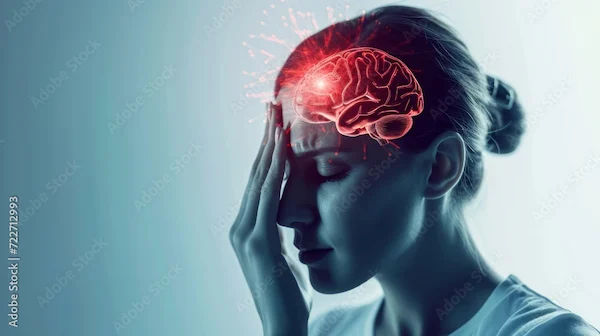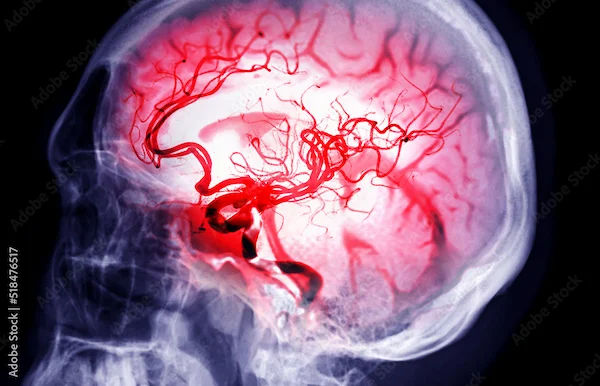Stroke Symptoms in Women: What to Watch for and How to Act
Learn the key stroke symptoms in women, including uncommon signs, and understand how to act fast. Early recognition can save lives—know what to watch for today.

Written by Dr. Sonia Bhatt
Last updated on 3rd Jul, 2025

Introduction
A stroke is a critical medical emergency that causes serious brain damage. While anyone can have a stroke, women may experience symptoms that are different from those typically seen in men, often appearing more subtle or harder to recognise. Strokes happen when the brain's blood supply is interrupted, either by a blockage (ischaemic stroke) or a burst blood vessel (haemorrhagic stroke). Recognising symptoms quickly is crucial for reducing brain damage and improving long-term outcomes.
Why Stroke Symptoms Can Be Different for Women
Women are at a higher risk of brain stroke compared to men, and their recovery from brain stroke can be more challenging, often resulting in greater rates of disability or sometimes even death. Different factors contribute to these gender differences, including hormonal differences, a higher prevalence of certain conditions, and longer life expectancy compared to men. Conditions like migraines with aura, high blood pressure during pregnancy (pre-eclampsia), and diabetes are more common in women and increase their risk. Additionally, women tend to live longer, which increases their chances of having a stroke due to the higher risk associated with ageing.
Stroke Symptoms in Women: What to Look For
The classic symptoms of stroke—summarised by the acronym FAST (Face drooping, Arm weakness, Speech difficulty, Time to call emergency services)—apply to both men and women. However, in women, stroke can present differently, and symptoms might not always align with the classic FAST signs. The following are more specific symptoms that women may experience during a stroke:
Sudden Severe Headache A headache described as "the worst headache ever" is more common in women, particularly in haemorrhagic strokes. This may be accompanied by nausea and vomiting and should not be dismissed as a typical migraine if it feels unusual.
Unexplained Nausea or Vomiting Nausea or vomiting, especially when paired with sudden headaches, confusion, or vision changes, could indicate a stroke. It’s important to seek immediate medical attention in such cases.
Difficulty Speaking or Understanding Speech Stroke often affects the speech centres of the brain. Women may experience slurred speech or difficulty understanding what others are saying, or they may struggle to find words. If this symptom appears suddenly, it's a red flag for a stroke.
Confusion or Disorientation Women may experience confusion, disorientation, or difficulty thinking clearly during a stroke. They might not recognise where they are or may be unable to understand simple instructions. This can be easily mistaken for other conditions but should be treated as a stroke warning sign.
Visual Disturbances Women are more likely to experience vision problems during a stroke, such as blurred vision, double vision, or sudden loss of vision in one eye. Vision changes should be taken seriously if combined with other stroke symptoms.
Pain, Numbness, or Tingling on One Side of the Body Unlike the more typical weakness or paralysis associated with stroke, women may feel pain, numbness, or tingling on one side of the body. These sensations can be confused with muscle strain or nerve issues but should raise concern if they come on suddenly.
Shortness of Breath or Difficulty Breathing Stroke can affect the brain’s ability to control breathing. Women may experience sudden shortness of breath or difficulty catching their breath, which can be confused with panic or respiratory problems. However, if it occurs with other neurological symptoms, it could be related to a stroke.
Severe Fatigue or Sudden Loss of Energy An overwhelming sense of fatigue that comes on suddenly, especially alongside confusion or numbness, is another possible sign of stroke in women. Unlike typical tiredness, stroke-related fatigue can feel sudden and intense.
Acting Quickly: The Importance of Immediate Action
If you suspect that you or someone you know is having a stroke, it’s important to act quickly. Every minute counts, as the sooner treatment is received, the less brain damage will occur. The following steps can help:
Call Emergency Services Immediately: Take immediate medical assistance. Don’t wait for symptoms to get better.
Note the Time: Track when symptoms first appeared. This information helps doctors determine the best treatment options.
Stay Calm: If the person is conscious, keep them calm and make sure they do not move around. If the person is unconscious, ensure their airway is clear and place them in the recovery position if needed.
Don’t Give Food or Drink: If the person is having difficulty swallowing, do not offer food or drink, as this could cause choking.
Risk Factors for Stroke in Women
Certain conditions and lifestyle factors increase the risk of stroke in women. These include:
High Blood Pressure: High blood pressure is the leading cause of stroke. Regular monitoring and management are essential, especially during pregnancy and menopause.
Hormonal Changes: Pregnancy, the use of birth control pills, and hormone replacement therapy (HRT) can increase stroke risk. Women with a history of pre-eclampsia or gestational diabetes are also at higher risk.
Diabetes: Women with diabetes have a higher risk of stroke compared to men with diabetes, partly due to hormonal influences.
Migraines: Women who suffer from migraines, particularly those with aura (visual disturbances before or during a migraine), have a higher stroke risk.
Obesity, Smoking, and Sedentary Lifestyle: These lifestyle factors increase the likelihood of stroke and should be managed through regular exercise, a balanced diet, and avoiding smoking.
Preventing Stroke: Tips for Women
Stroke prevention is a critical part of maintaining overall health, particularly for women who are at a heightened risk. By adopting healthy lifestyle habits, managing existing health conditions, and making mindful choices, women can significantly reduce their chances of experiencing a stroke. There are several ways women can reduce their risk of stroke:
Adopt a Healthy Lifestyle: Regular physical activity, a balanced diet, and weight management are essential for stroke prevention.
Control Blood Pressure: Managing blood pressure through lifestyle changes and medication is one of the most important ways to reduce stroke risk.
Quit Smoking: Smoking increases stroke risk by raising blood pressure and damaging blood vessels.
Manage Chronic Conditions: If you have diabetes, high cholesterol, or other health conditions, work with your healthcare provider to manage them effectively.
Conclusion
A stroke is a grave medical condition that can have devastating effects on the brain and overall health. While strokes can affect anyone, women are often at a higher risk and may experience symptoms that are more subtle, atypical, or harder to recognise. This makes it even more critical to understand the unique ways in which strokes can present themselves in women and to remain vigilant for any signs of a potential stroke. Recognising these warning signs early—especially the more subtle ones like severe headaches, unexplained nausea, confusion, or visual disturbances—can make a world of difference in the outcome of the situation. Every moment counts when it comes to strokes. The longer the brain goes without proper blood flow, the more damage is done, which can significantly impact recovery and long-term quality of life. Immediate action, such as calling emergency services at the first sign of a stroke, ensures that medical professionals can begin life-saving treatment without delay. Time is of the essence, as prompt intervention can not only minimise the extent of brain damage but also increase the likelihood of survival and a better recovery.
Consult Top Neurologist
Consult Top Neurologist

Dr. Amit Kapoor
Neurosurgeon
18 Years • D.N.B NeuroSurg.
Delhi
Apollo Hospitals Indraprastha, Delhi
Dr. Lakshaman K
Neurologist
19 Years • MBBS,MS General Medicine,MCH Neurosurgery
Bengaluru
R V speciality Clinic, Bengaluru

Dr. Dhruv Zutshi
Neurologist
17 Years • D.M (Neurology), M.D (Medicine), MBBS
Delhi
Apollo Clinic East Of Kailash, Delhi

Dr. Uddalak Chakraborty
Neurologist
8 Years • MBBS, MD(GENL.MED.),DM(NEUROLOGY)
Kolkata
MCR SUPER SPECIALITY POLY CLINIC & PATHOLOGY, Kolkata

Dr. Joydeep Biswas
Neurologist
15 Years • MBBS, DNB General Medicine, DNB Neurology
Barasat
Diab-Eat-Ease, Barasat
.webp)



